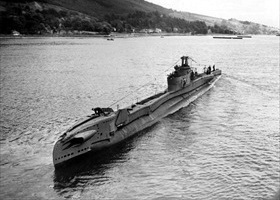SUB USES DECK GUNS TO SINK JAPANESE VESSEL
Aboard the USS Pollack in Pacific Ocean · March 11, 1942
On this date in 1942 the USS Pollack made the first submarine attack using only its deck guns. Its targets were two Japanese fishing boats. During 1942 U.S. submarines reported 34 gun attacks on sampans and trawlers. The number of attacks increased to 64 in 1943, the same year a U.S. Seventh Fleet bulletin put an official imprimatur on surface gun attacks after launching unrestricted submarine warfare on Japanese vessels within hours of Pearl Harbor. The July 30 bulletin advised that submarine gunfire could be effectively used against junks, schooners, and other small vessels. Their sinking over the long haul, the bulletin advised, would produce impressive results. The Japanese, suffering mounting shipping losses to their merchant fleet, increasingly resorted to smaller craft to move personnel, supplies, and even heavy equipment between Pacific islands and along their own coastline. Prisoners captured from junks confirmed that the Japanese were using such craft to ship rubber, timber, tin, rice, tea, and shark liver oil, which was used to lubricate Japanese aircraft engines. Typically owned by Chinese using a mixed crew of Chinese, Malays, and Indians, a 100‑ton junk might carry enough rice to feed 2,000 Japanese soldiers for three months. Many submariners felt that attacking fishing craft, and hence Japanese food supplies, was entirely justifiable. When the submarine HMS Thule sank nine junks in a single day in December 1944, its British skipper claimed his actions had destroyed enough rice to feed 5,000 Japanese troops for months. However, some skippers believed these close-range surface gun battles were “just too much”—“intolerably personal” in the words of one sailor—and so they reluctantly engaged or declined to engage in these attacks. Whether to attack and sink these defenseless or lightly armed vessels remained a persistent dilemma, both moral and tactical, throughout the war even as the number of vessels sunk by deck guns rose. In 1944 the number of small craft successfully attacked by deck gunners aboard U.S. and British submarines climbed to over 300, jumping to nearly twice that many in 1945 before hostilities ended in August. By war’s end most large Japanese fishing vessels in Southeast Asia had been destroyed in the context of “total war” against Japan.
[amazon_carousel widget_type=”ASINList” width=”600″ height=”200″ title=”Recommended Reading” market_place=”US” shuffle_products=”False” show_border=”False” asin=”0813141109,1603440836,1591145325,1591147786,0891415726,1574887343,155750217X,0252066707,1450298915,0743487990″ /]
Two Allied Submarines Acting as “Commerce Raiders” in the Pacific
 |  |
Left: The 300-ft-long USS Pollack, like the USS Porpoise shown here, had four forward and two aft torpedo tubes, one 4‑inch/50 caliber (102mm) deck gun, and four 7.62mm machine guns. The Pollack conducted eleven war patrols. On her last patrol she used her deck gun to shell the phosphate plant on Fais Island in the eastern Caroline Islands in late-August 1944. The Navy conferred ten battle stars on the Pollack for meritorious service during the war.
![]()
Right: In addition to 11 forward and aft torpedo tubes, the 276‑ft‑long HMS Thule was armed with one 4‑inch deck gun and three anti-aircraft machine guns. In one twelve-day period between December 17 and 29, 1944, the Thule sank thirteen junks, five sampans, and two lighters with gunfire in the Strait of Malacca, the narrow stretch of water between the Malay Peninsula and the island of Sumatra that connects the Pacific Ocean with the Indian Ocean. In 1945 the Thule sank a further five sailing vessels and three coasters.
“Victory at Sea” Tribute to World War II Submariners
![]()

 History buffs, there is good news! The Daily Chronicles of World War II is now available as an ebook for $4.99 on Amazon.com. Containing a year’s worth of dated entries from this website, the ebook brings the story of this tumultuous era to life in a compelling, authoritative, and succinct manner. Featuring inventive navigation aids, the ebook enables readers to instantly move forward or backward by month and date to different dated entries. Simple and elegant! Click
History buffs, there is good news! The Daily Chronicles of World War II is now available as an ebook for $4.99 on Amazon.com. Containing a year’s worth of dated entries from this website, the ebook brings the story of this tumultuous era to life in a compelling, authoritative, and succinct manner. Featuring inventive navigation aids, the ebook enables readers to instantly move forward or backward by month and date to different dated entries. Simple and elegant! Click 











